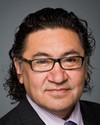Thank you very much, Madam Chair.
[The witness spoke in the Innu language.]
If I may, I would first like to pay tribute to the Anishinabe Nation for welcoming us on their land. As I say every time, many moccasins have trod on Parliament Hill, on this beautiful land, to remind Canadians that we, the aboriginal peoples, are and will always be proud of who we are.
It would also be important to pay tribute to all those people we work for on a daily basis: families who have lost a mother, a sister, a cousin, a child or a granddaughter. In the past two months, in my nation alone, three young Innu women have been murdered or held against their will for several weeks. I would like to pay tribute to them. If you would like to pay tribute to them, we could observe a minute of silence for all missing or murdered women, a phenomenon that has been happening here for too long.
[A moment of silence observed]
Thank you very much.
[The witness spoke in the Innu language.]
This is our first meeting, and I hope it isn't our last. I would also like to share a bit of our perspective with you and tell you what we, at the Native Women's Association of Canada, feel about this reality that I call a national tragedy, a tragedy that affects everyone. In fact, we all are close to someone who has lost a child or dear loved one.
I must also say thank you very much for giving us the opportunity to speak with this committee. This is how I see the role of the Native Women's Association of Canada with you, dear MPs, who represent the various regions of Canada. It is an opportunity to exchange and have debate, but healthy debate. That doesn't mean we are always going to agree on the same ideas or understand everything we are going to discuss. That isn't how it works in a family, either. However, I hope we can do this respectfully, because we are talking about human lives and dignity here. People really have a lot of hope in the committee's role, but also in the role of the Native Women's Association of Canada. I think that, if we work together, we can surely bring about great change.
The Native Women's Association of Canada was founded in 1974. Allow me to provide a brief summary of who we are and where we're from. Our association has been advocating for several decades for individual rights, collective rights, the environment and human rights. We condemn discrimination, racism and sexism, but always in a constructive way, to enable our societies to live in safety, in dignity, obviously, and far from violence.
Our role here today, in fact the role we are going to try to build together with all of you here, is to better understand how the Native Women's Association of Canada will be able to fuel the debate and contribute to the committee's work through expertise, passion, love and knowledge of women across Canada and the member organizations. This represents a lot of people.
There are various issues that we are concerned or unsure about. Perhaps we also have solutions, quite simply, who knows? I would also like to say that we are currently in discussions with elected officials and colleagues within our organization. We do not see ourselves as witnesses, as we are known as here, but rather as partners or people who can help move these causes forward. I don't think we have the same status as everyone who comes and appears as a witness. I think it will be important to clarify that and agree on it formally.
In April, we sent a letter to the chair to find out how we could discuss the role of the Native Women's Association of Canada, the understanding of the process and how we could be involved in this exercise.
We also sent an email this week, I believe, explaining how our organization would work in good faith and goodwill in the coming months and over the next year.
Madam Chair, I was pleased that your introduction helped us understand the nature of our role a little better. However, I think it will be important to establish a much more official dialogue between the chair and me, or between the chair and our organizations. I think that we are going to find good solutions.
We are not here today to set aside the national public inquiry to document the situation of missing and murdered women. That remains a priority for us. We say this to all tribunals, be they local, regional or national. We recently said before the United Nations in Geneva and New York, and I will say it again next week in Norway: we want a national public inquiry.
As we have seen recently, a lot of people are calling for inquiries when money is misspent or when things happen in elections. We demand inquiries. It is normal. In this case, we are talking about a large number of missing women who have never obtained justice. Perhaps the problem is systematic. A national public inquiry would therefore shed some light on the issue and bring about solutions.
We are holding fast in our position. We want and demand a national inquiry. We also support the committee in its work, and hope that the NWAC's role will be clarified in the coming days.
It is clear to us that this is not just an aboriginal issue.
This is not an aboriginal issue. For us as mothers, grandmothers, and women—and I hope our brothers will come along with this—this is a Canadian issue and also a human rights issue.
I say that from my heart. I'm a passionate person, and I know that our office and the board of directors have the same goal in this exercise. We want to work in partnership and, of course, collaborate with this committee and the aboriginal affairs working group because we know for sure that since 1974, we have been developing that expertise on family violence, elders, and sexual abuse. There are many things we do, including research and training, databases, etc. We were a witness on several committees. We went all over the world learning and exchanging with respect to this expertise. We do need to work together, and I believe we'll find a good way.
Over the years, other organizations have noticed that we have that expertise. The Assembly of First Nations is mostly led by men. I know that more and more of our men are part of the strategy and solution with respect to ending that violence in our communities. I'm glad to say that AFN is also a partner with NWAC on this issue. We had a huge forum in Edmonton. There were probably 450 men and women from across Canada, chiefs and grassroots.... We had a strong three-day discussion with recommendations on ending violence against women.
We also work with first nations governments, not only with AFN but also with communities and with 11 provinces and territories on this issue. Each time we had an aboriginal affairs committee working group where the ministers responsible for aboriginal affairs and some premiers were there. I had the opportunity to have two meetings with them in December, and not long ago. We were so honoured to witness what I call a historical moment. For many years they didn't want to have a national public inquiry. For many years they were saying that a national task force would cost too much money, and other things like that.
After two meetings, NWAC was able to present something to them to say that the issue belongs to all of us. It's not only an NWAC issue.
I was so pleased to hear that they agreed to send a letter to Minister Valcourt and Prime Minister Harper saying that this committee and 11 provinces and territories support NWAC and AFN in wanting a national public inquiry.
We have the international aspect, and we have the other provinces and territories across Canada. They all think there is a need to go further. That's great. I was proud to be part of that historic moment. Let's hope we'll have some more.
Every day we work with families. I call them families—the Stolen Sisters and Sisters in Spirit. We work with them in order to prevent violence, to make sure we are there to support and to listen. We may gather with them once or twice a year just to make sure they're not forgotten. Those moments are so important to them, to know they're not isolated. Their stories are the same, whether they're from Yukon or from P.E.I., and it is important that we work with them.
For me, working with the people...and you all do. You were elected and you're accountable to the people in your respective regions. This is why we are in politics. This is why we decide one day to stand up and run for a position, to do something for people. For most of us, it's not for the salary; it's for our love for the people. We listen to them. They're the ones who give us the fuel, the things to say or do. Maybe they can't afford to do this themselves, or maybe they're not comfortable doing it. For us, those gatherings are really important.
Madam Chair, I hope you and your colleagues will take half a day or a couple of hours to listen to families. I'm from the Innu nation, and it's so Innu to listen to the person. It's probably your first experience in a different culture. Let's try that for an afternoon or a night. Let's gather a few families together and listen to what they have to say. While I don't promise anything, I believe that doing this might change some thoughts in your mind, and it might make you feel differently. They gave me the flame, in French la flamme after listening to many families. I work for the families and the women in the things I do every day. They are so close to my heart. It would be great if you had a special event or something with the families.
Of course, in order to address this issue we have to make sure that we correctly identify.... We all know, I hope, the root cause. There are many reports, databases, and Statistics Canada data, etc. It is obvious that housing is a problem, as is the legacy of the residential schools. Even if we didn't go to the residential schools, our generation, I'm sad to say, is still affected by what happened there. I won't tell you my personal story, but it's everybody's story across Canada for first nations, Métis, and Inuit women in our generation who are still affected by that era.
We also have to take other issues into consideration. Housing, homelessness, addiction, racism, sexism, child sexual abuse, mental health, which is a big issue, negative government policies, historical victimization, gender factors, trafficking are all big issues in our community.
Trafficking is a big issue. We don't talk a lot about it, but it is there, and it's sad that aboriginal and indigenous women are affected by it.
It is past time that those individuals, processes, and policies responsible for maintaining the status quo and the subsequent harms to aboriginal women and girls be remedied.
It is also important that we see....
I'll switch to français for my own sake, and I'll come back en anglais to be polite to the rest who don't speak French.
It will also be good for me to speak in French for a bit.
It is important that you know that you have an extremely important role to play in the work to be done. We have seen a number of committees. I have been involved in aboriginal politics for 20 years now. That's 20 years of giving my heart to aboriginal women and, believe me, I'm giving it. In 20 years, we have seen it, committees, briefs, reports and so on. I would like you, Ms. Ambler and all the members of the committee, to ensure that this time, things are different and that the committee's recommendations are different. We are not just going to choose recommendations that are the least costly or the recommendations that are short term, or simply choose them based on a political capital. I'm asking you to find solutions here that all Canadians can benefit from in the short, medium and long term. It's a good exercise.
There have been various fora at several levels, federal, regional and community, in which national aboriginal organizations and aboriginal women's groups, including the Native Women's Association of Canada and its member organizations, have tried to make their recommendations heard.
Also, as you surely know, there were two editions of the national aboriginal women's summit that resulted in some very interesting recommendations that might be part of this exercise.
There was also the Assembly of First Nations national justice forum, where a significant portion of the second day was spent on missing or murdered women. Recommendations were made there, as well.
As I said, we recently had a summit with the Assembly of First Nations, and we are still working on the recommendations.
Keep in mind that British Columbia co-hosted an event with the Native Women's Association of Canada. It was a good exercise that, once again, gave rise to interesting avenues on the issue that this committee is studying.
I repeat that it is important not to simply take these recommendations lightly, but to invest in people. We are talking about women and families who deserve justice and answers.
We have presented this situation in many regions in Canada and in many countries. Quite recently, Canada had to submit an accountability report as part of the Universal Periodic Review to the United Nations in Geneva. I'll tell you that our organization worked really very well with the member countries that Canada was to respond to. We also felt the solidarity from the international community, which was concerned about what was happening here, in Canada. So it's everywhere. Although we are no longer active internationally for the moment—I'd be surprised if it stayed that way since nothing can stop me—the message was put out there, internationally.
Quite recently, we submitted a request to the United Nations Committee on the Elimination of Discrimination Against Women. Ms. Ameline is the chair of the committee. I met with her last week in New York, and I highlighted how important it is for the special rapporteur to work with us if she or he came to Canada. It's important. You also have the opportunity to show, internationally, that you really want to eliminate those statistics to make way for prevention and the safety of aboriginal women across Canada.
We had the opportunity to meet three times with members of the Organization of American States as part of the Inter-American Commission on Human Rights. Quite recently, still as part of the Organization of American States, we reiterated our support. Lastly, Canada—thank you very much—agreed to bring the three special rapporteurs here. To date, on the international and inter-American levels, meetings have been held with the attendance of the special rapporteur, James Anaya, an official from the Inter-American Commission on Human Rights of the Organization of American States and Ms. Ameline of the CEDAW.
All these people are aware of the situation. Every time, I invite them to come and see the situation, while telling them that I am convinced that we can change things together if we take a constructive approach. It's always a hope. However, if things don't budge, there might be recourse at the international court, but I don't think we need to go that far. At least, I hope not.
In Canada and the United States, there is a situation that some may feel is emerging, but that we know has existed for far too long, and that is the trafficking of women. And then comes prostitution. It is clear that prostitution and trafficking are closely linked, unfortunately. I hope you know that. For us, it clearly violates human rights.
We are talking here about poverty, vulnerability. In the very beginning, we mentioned homelessness, housing problems, extreme poverty, the repercussions of residential schools. Canadians might be wondering what the connection is between the schools, the lack of housing and poverty. These are all health determinants, factors that make aboriginal women five times more likely to die of a violent crime. In many cases, the profile of these women fits into the examples I just gave you.
It is clear that there really is a systemic problem. Trafficking is becoming increasingly…
Madam Chair, I know that this is not our role, but in my heart, as an advocate, I think it would be interesting to look at the links between aboriginal women, trafficking and prostitution, as well as the factors that mean that our children and our daughters are in situations where they are extremely vulnerable. They are taken away before they are 18 years old and then end up in prostitution. I'm hearing some groups say that these people have the right to choose what they do with their body and their life. But we have to keep in mind the fact that these young people might have gotten involved in an unhealthy environment before they were 18.
For us, violence clearly is not acceptable, and I'm sure all of us around this table agree. We have focused on very, very serious violence for many years.
Violence affects aboriginal women, our children, our families. I will share with you some stories and events that happened in our communities across Canada. They are sad stories, and they're true.
Back in the day when Paul Bernardo killed two white girls, every Canadian, even me, knew the names of the two girls, Leslie Mahaffy and Kristen French. Everybody knew their names. But we have to remember, and we do, that in that same period, a number of aboriginal girls went missing, and today Canadians still don't know their names.
A shocking 1996 government statistic reveals that indigenous women between the ages of 25 and 44, with status under the Indian Act, as I said earlier, were five times more likely than other women of the same age to die as a result of violence. The numbers used here come from a federal organization. Today in 2013, aboriginal women are still facing that reality every day.
In two separate instances in 1994, two 15-year-old indigenous girls, Roxanna Thiara and Alishia Germaine, were found murdered in Prince George. The body of a third 15-year-old indigenous girl, Ramona Wilson, who disappeared that same year, was found in Smithers, in central British Columbia, in April 1995. Only in 2002, after the disappearance of a 26-year-old non-indigenous woman, Nicola Hoar, while hitchhiking along a road that connects Prince George and Smithers, was there media attention all over Canada. Her name was also on a list of the unsolved murders and other disappearances along what has been dubbed the Highway of Tears. But what about the other indigenous girls?
This is my last story for you today. In 1996 John Martin Crawford was convicted of murder in the killings of three indigenous women, Eva Taysup, Shelley Napope, and Calinda Waterhen, in Saskatoon, Saskatchewan. Warren Goulding, one of the few journalists to cover the trial, commented. “I don't get the sense the general public cares much about missing or murdered aboriginal women. It's all part of this indifference to the lives of aboriginal people. They don't seem to matter as much as white people.” That comes from one of your brothers.
The disparity between recommendations being made by aboriginal women at these events, such as, NAWS, the National Aboriginal Women's Summit, the Joint AFN-NWAC National Forum, and so on, and the one I named earlier in the presentation, and what government is actually doing is getting way too big. But I have a strong feeling—and we do, we had that discussion—that we will be able to—we have to—make sure that those numbers decrease until we don't have any more missing and murdered sisters.
There are many things we can do, but we have to work together. We have to work with the families. We have to work with the grassroots organizations.
We heard the same thing when we discussed this. When I met with several ministers from the Harper government, I heard that we have the same views. Action for us is important. We have to focus. I often heard some of your colleagues talk about action. It's the same for us. We have something here that connects us. We have to focus on action.
To implement the action we need, as I said, we have to work together. Funding is also necessary, not only for the Native Women's Association of Canada, but also the PTMAs, the members of NWAC, the organizations, volunteers, women who gave their heart and love to their region, but also other grassroots or first nations communities, Métis organizations, and Inuit. They need to have proper funding and the proper resources in place to prevent violence.
I will conclude this part, because we are a team and her English is way better. If the committee continues its work, and I'm sure it will after listening to your opening remarks, Madam Chair, but if the work is done without the full participation of the Native Women's Association of Canada, we will not be able to endorse this work. But I'm sure we'll officially find ways. We already had a good discussion with Madam Chair on how we can make sure, and the special advisory position is something we're really comfortable with. The dialogue between meetings will be important, making sure we can connect as much as possible to exchange some information, etc.
I have lots of hope, Madam Chair. I had a good meeting with you, so the hope is still there.








